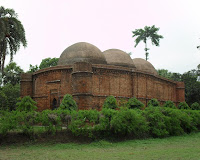 |
| Kherua Mosque, Sherpur, Bogra Photo taken from: http://icwow.blogspot.com |
This
is an old mosque situated in the village, Khandakartola, under Sherpur Upazila in
the district of Bogra. Locally it is known as “Kherua mosjid” (Kherua mosque). The
mosque had been built more than 400 years ago, in the year of 1582 A.D. by some
Mirza Murad Khan Qaqshal, son of Jauhar Ali Khan Qaqshal. The Qaqshal was an
Afghan tribe that, along with other Afgfhan groups who followed Masum Khan
Kabuli, who declared himself as “Sultan” and sought to oust the Mughals from Bengal.
At a time Sherpur, where the mosque has been situated, had served as the
headquarters of the rebels.
According
to the Mughal architecture, their mosques consist of only a prayer hall, which
is now single-aisled with three or five bays. The exterior surfaces are
plastered and paneled, the cornices are straight, and the buildings look less
ponderous than Sultanate ones because of the higher domes.
 |
Kherua Mosque
Plan: Sketch been taken from Banglapedia.org
|
The
Kherua mosque is a single-aisled, three domed (bayed) mosque which represents the North
Indian and Mughol era architectures in Bangladesh. But it also carries the
Bengali features, such as the brick construction, curved cornice and engaged
ribbed corner turrets, the plan is whole divergence from that of traditional
Bengali mosques.
However,
ironical fact is that, this mosque has been represented the symbolic type of the
standard of Mughal and post-Mughal era in Bengal.
 |
| Kherua Mosque Photo taken from: http://icwow.blogspot.com |
It
resembled the fact that the ruler, Masum Khan Kabuli, and many of his rebel
followers who had served earlier in Bihar under the Mughals, were familiar with
north Indian forms (like the forms of Delhi and Agra), as well as with mosques
in the great stronghold of Rohtas in Bihar. The older Hindu sculptures (like which
found in Kantaji’s Temple in Dinajpur) were known to have been imbedded in the
east façade, but it was already damaged. The only visible part of Kherua mosque
is of its back side, that part is carved with a Persian inscription. Re-usage
of Hindu materials in such a prominent fashion is rare in Bengal after 14th
century. The Qaqshal rebels were probably cut-off from sources of freshly
quarried stone, which would have been used for an inscription on a brick
monument, and so had to rely on available materials.
 |
| Kherua Mosque Photo taken from: http://icwow.blogspot.com |
This
historical mosque has been situated just around 14 km away from the upazila
town of Sherpur.
This
beautiful archaeological site is now falling into ruin due to the lack of
proper maintenance. The salinity of this area is high and its’ 2 meter width
walls are now under threat of that salinity.
No comments:
Post a Comment